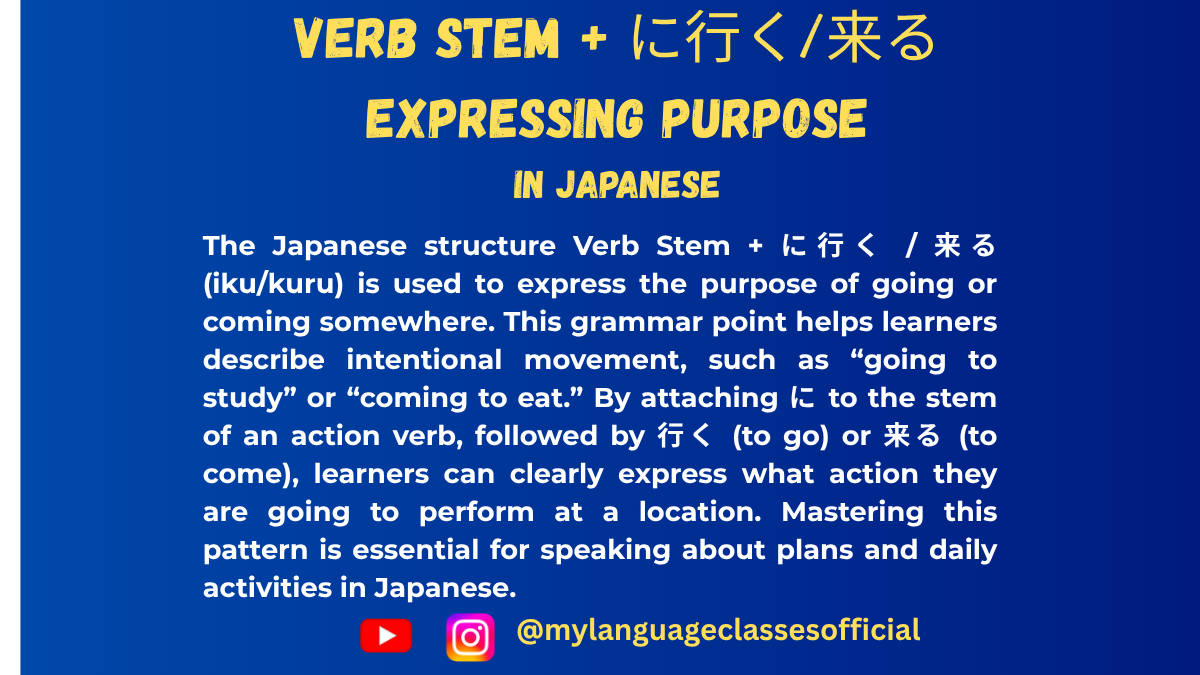Your cart is currently empty!
Tag: Japanese verb stems
-

How to Express Purpose in Japanese Verb Stem + に行く / 来る (iku/kuru) | My Language Classes
How to Express Purpose in Japanese: The Structure “Verb Stem + に行く/来る
When learning Japanese, one of the key steps toward fluency is understanding how to express purpose. Today, we’ll focus on a practical and widely used grammatical structure: Verb Stem + に行く/来る. This structure is an essential tool for expressing why someone is going somewhere or has come to a specific place.
The Basics: What Does It Mean?
In English, we often say things like, “I go to the park to exercise” or “She comes to the café to study.” In Japanese, you can convey this idea using the Verb Stem + に行く/来る pattern. Here’s how it breaks down:
- Verb Stem: The base form of the verb without its conjugative endings (e.g., ます or る).
- に: A particle indicating the purpose.
- 行く (いく): “To go.”
- 来る (くる): “To come.”
Building the Structure
To form sentences using this structure, follow these steps:
- Start with the stem of the verb that represents the action or purpose.
- Add the particle に.
- End with 行く (if the subject is going to a place) or 来る (if the subject is coming to a place).
Examples:
- To go to eat sushi
→ 寿司を食べに行く
(すしをたべにいく) - To come to study
→ 勉強しに来る
(べんきょうしにくる) - To go to shop
→ 買い物しに行く
(かいものしにいく)
Key Points to Remember
- Focus on the Verb Stem
The “stem” is the form you get when you remove ます from a polite verb or drop the ending る from plain る-verbs.- Example:
食べます → 食べ (stem)
飲む → 飲み (stem)
- Example:
- Particle に
The に particle acts as a marker that connects the purpose to the destination. - Directional Verbs
- 行く implies movement toward a place.
- 来る implies movement toward the speaker’s current location.
- Negative and Past Forms
Like most verbs in Japanese, 行く and 来る can be conjugated.- Negative:
寿司を食べに行かない (I won’t go to eat sushi.) - Past:
勉強しに来た (I came to study.)
- Negative:
Polite and Casual Speech
When speaking with friends, you might use the plain forms 行く and 来る. However, in formal or polite contexts, switch to 行きます and 来ます.
- Polite:
図書館に勉強しに行きます。
(としょかんにべんきょうしにいきます)
“I will go to the library to study.” - Casual:
図書館に勉強しに行く。
(としょかんにべんきょうしにいく)
“I’m going to the library to study.”
Common Mistakes
- Forgetting the Verb Stem
A common error is using the dictionary form instead of the stem. For example:
❌ 食べるに行く
✅ 食べに行く - Mixing Directional Verbs
Be careful to choose 行く or 来る based on the context of movement relative to the speaker.
Practice Makes Perfect
To master this structure, try creating sentences based on your daily activities. For example:
- I will go to the market to buy vegetables.
→ 市場に野菜を買いに行きます。
(いちばにやさいをかいにいきます) - They came to the park to jog.
→ 彼らは公園にジョギングしに来ました。
(かれらはこうえんにジョギングしにきました)
Final Thoughts
The Verb Stem + に行く/来る structure is a powerful and flexible tool for expressing purpose in Japanese. Whether you’re a beginner or advancing in your studies, mastering this form will add clarity and fluency to your communication.
What activity will you use this structure to describe today? Share your example in the comments, and let’s learn together!
If you enjoyed this lesson, be sure to check out more posts like this on my blog at My Language Classes. Don’t forget to subscribe my YouTube channel and follow me on Instagram for the latest language learning tips and lessons. Leave a comment below to share your thoughts, or ask any questions you have about nouns.
Happy learning! 😊
